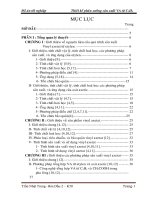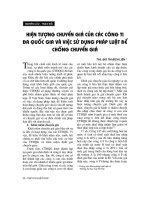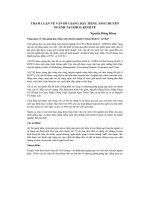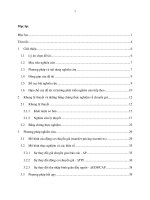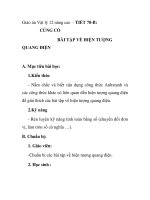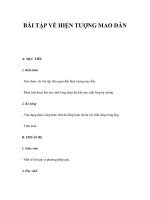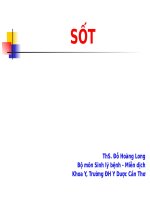bài luận về hiện tượng chuyển giá (tiếng Anh)
Bạn đang xem bản rút gọn của tài liệu. Xem và tải ngay bản đầy đủ của tài liệu tại đây (199.35 KB, 27 trang )
CONTENT:
PREFACE
At the press conference in the third quarter of 2015, Mr. Nguyen Dai Tri, the Deputy
Director General of General Department of Taxation, indicated that within 9 months of
2015, the tax industry inspected and found out that 1,600 enterprises had signs of transfer
pricing. This is a big number. For FDI enterprises, Mr. Tri showed that the General
Department of Taxation was conducting checking to make it clear about the query of
signs of transfer pricing towards Metro and Coca Cola.
In discussion session about Vietnamese economy with affiliation at Global
Investment Forum in 2015, the Minister of Ministry of Planning and Investment, Mr. Bui
QuangVinh, didn’t agree with a corporate leader’s opinion blaming Coca Cola for
transfer pricing without any evidence.
Transfer pricing has appeared for a long time, but now it continues to emerge in
Vietnam again. It is likely to say that on the time being, transfer pricing is a hot topic in
Vietnam lately.
So, what is transfer pricing? How does it occur in Vietnam, especially in Coca Cola?
In order to make the problem clearer, our group has decided to choose the subject:
“Transfer pricing in Coca Cola” for our research. However, this problem is quite new in
Vietnam, it is not able to avoid mistakes in our report. Therefore, we hope that you will
help us find out and correct them. Simultaneously, we also send our special thanks to
Mrs. Tran Thi Thu Hien, who guided us enthusiastically so that we can complete this
research well!
1
TRANSFER PRICING
1.
Introduction to transfer pricing:
1.1
Definition:
According to theory, transfer pricing is practicing the price policy towards
goods, service and assets that are moved among members in a corporation of link
group, but not following the market price in order to minimize the amount of tax
belonging to corporations or link groups. In another word, transfer pricing is
business subjects’ behaviors affecting the price to change the value of exchanging
goods, services in relationship with sides of corporations or link groups.
Transfer pricing occurs due to rights to make decisions freely in business.
Subjects in the same corporation or link group have general benefits, so the
difference of price doesn’t change the total benefit. Changing price doesn’t change
the total benefit, but it change the total tax obligation because the tax duty is
moved from a high regulated place to the lower one and contrarily.
The nature of transfer pricing is a form of applying the price policy among
sides having link relationship that does not follow normal exchange price in the
market in order to minimize the number of payable tax belonging to all sides.
Transfer pricing will lead to the increase in the number of payable tax of links
origin in this country, at the same time reduce the amount of payable in other
countries, but after all sides reduce the quantity of payable tax.
However, it is very difficult to determine if a subject doing transfer pricing
because there are states failing to collect tax, as well as other states collecting
2
bigger number of tax. In fact, international transactions are more worrisome than
domestic ones because of the difference in tax policy among different countries.
In addition to ways of transfer pricing based on tax policy above, transfer
pricing can be based on preferred policies among countries. Income will be moved
from subjects having lower preference to ones having more advantages about
preference.
1.2
Signs:
1.2.1
Suspicious signs:
Company measures and declares inaccurate revenue and costs, shows
ongoing earnings losses for years as well as equity loss. However, they
continue to operate, and even expand investment and producing.
Price of goods and services the company sells to linked trading units is
lower than when they sell to independent ones.
Price of purchasing raw materials, goods and services from foreign parent
company are higher than purchasing from other independent units, which leads
to higher costs.
Goods, services exported to foreign countries (mainly the ones that are
output contracted through parent company) have a phenomenon of which their
selling price and outsourcing price are lower than cost price. This leads to
continuously loss in production and business operations for many years. To
continue to operate, the company needs to use some form of financial aid, or
loans without interest from parent company.
Parent company allocates costs incurred overseas to its subsidiary several
items such as advertising, marketing, researching and expanding market,
interest expenses, copyright and some more, which actually must be paid by
the parent company abroad.
1.2.2
Signs on financial statements:
3
•
Costs of goods and services are high:
Costs of goods and services (COGS) are part of business’ costs
(including COGS, management costs, sales costs, and financial costs).
However, through examination, COGS in the company are generated very
high (over 90%, even higher than the selling price).
• Outsourcing process is done by other company:
Production capacity in the company is limited by machinery,
equipment, production ground, the number of employees and many more,
but they still sign contracts with foreign customers that exceed their
production capacity. With the reason of ensuring the volume of contracts
they signed, these companies hire domestic firms to outsource their
products. After consideration, the price of this is almost equal or even
higher than price signed with foreign companies. However, rate of hiring
domestic companies to outsourcing is very high (nearly 80% of production)
and happened for many years.
• Large advance payments from customer:
Balance on report of payables and receivables is large in some
companies (prepaid expenses of customers). The advance payment amount
is very high, sometimes not stipulated in the contract. It does not comply
•
with any principles (such as based on the value of contract signed).
Foreign loans:
After years of continuous losses, to ensure balance of business capital,
the firm decides to sign foreign loans contracts. These contracts are usually
funded by the parent company or individual entrepreneur. Many contracts
do not charge interest, not specify time of the loan. This is to avoid paying
withholding tax on loan interest.
•
Increasing legal capital:
After losing consecutively for years, some enterprises use the form of
increasing legal capital, aim at expanding production scale and balance of
capital on accounts.
• Supporting outsourcing price:
4
To ensure balance and cope with management agencies, when parent
companies abroad feel the loss is too big, they usually do not adjust the
outsourcing price, but choose the solution of supporting the price to make
up cost of subsidiary companies.
These are the enterprises specialized in manufacturing, processing
goods to export. Therefore, although the business continuously loses, incurs
negligible tax liability (such as excise tax and personal income tax), but the
tax that state budget must refund to the business (value-added tax of goods
and services purchased) are great.
1.3
Forms:
•
Enhancing the value of contributed assets (venture investment):
Raising the value of contributed assets will make contributed capital
of parties that want to lift the value of capital contribution increase.
Therefore, both the domination of decisions related to operation of joint
venture projects and profit divided will increase. Moreover, this method
makes the annual depreciation rate increase, so it also makes input costs
•
rise and income tax payable reduce.
Enhancing the value of intangible assets (value of technology, brand
name…):
Accurate valuation of intangible assets of investors is very difficult to
confirm, evenwhen multinational companies (MNCs) show the certificate
of audit companies because its reliability is hard to confirm. Therefore, they
deliberately inflate the capital contribution by brand, recipes, technology
transfer ... in order to increase its equity.
• Importing raw materials from the foreign parent company, or from partner
companies in joint venture with high prices:
This is a form of transferring profit abroad through the payment of
imported goods. Besides,this method makes costs increase, so that income
tax payable of FDI enterprises will decrease.
• Raising the cost of administrative units and management:
5
The parent companies often use consulting contractsor hire
intermediaries. Venture partners of these MNCs received experts or
managers are forced to pay a very high cost (salary),whichhowever is
resulted in low efficiency.
• In some cases, MNCs make the transfer prices through overseas training
form:
Many firms select employees to study and practice in the parent
company with the high cost.
• Regulating the sale and purchase price of goods:
If import tariffs are high, parent companies will sell materials and
goods with low price to avoid import tax payment. In this case, they will
strengthen the counseling, training, marketing support with high prices to
offset or acquire products with low price. In opposite situation, if imported
goods have low tax rates, the MNCs sign import contracts at high prices in
•
order to increase costs to avoid income tax payment.
Sponsoring business loans of parent companies:
In this way, the subsidiary generate capital structure and unreasonable
capital such as using loans from parent company to finance fixed assets and
long-term invested assets without increasing capital as well as equity to
push costs of financing activities (foreign exchange costs, interest
expenses...) higher. Then, they transfer a part of profits in form of interests,
costs of loan guarantee to avoid tax and foreign exchange losses in the
•
future.
Through Bill Renewable Center:
Bill Renewable Center acts as an intermediary between the parent
company and its subsidiaries. Goods on invoice vouchers are sold from the
company produces goods through Bill Renewable Center, then this center
again sell to distribution companies by invoicing and enclosed documents.
This will help to reposition the currencies of both production units and the
center. But in fact, the goods are delivered directly from manufacturer
6
through distribution companies without through the Bill Renewable Center.
Therefore, the difference brings the amount of sales which is not taxed.
1.4
Influences:
1.4.1
•
For multinational corporations:
Positive:
Transfer pricing makes sure that MNCs receives some kind of
benefits, such as reducing tax duty, maximizing profit by using operating in
country that has low taxes.
Transfer pricing allow MNCs to easily move profit or financial
investment to their own country or foreign ones.
If MNCs make a financial contribution by machines and equipment,
they can easily modernize technology by liquidating backward equipment
and out-of-date technology with high price for company in which they
•
invest in foreign countries.
Negative:
If MNCs really do transfer pricing and be found out, they will suffer a
big penalty, be dispossessed business license and their fame will be
influenced. Furthermore, they will be administered closely when they
invest in other countries.
1.4.2
•
For countries receiving investment:
For economy:
Transfer pricing creates unfair competition environment between
domestic firms and foreign ones. The FDI firms that own dominant position
makes domestic economy depend on foreign firms. It also is one of the
reasons that lead to trade deficit on facilities, materials, technology with
high price while doing exportation with low price.
• For government:
- Reduce revenue from tax.
7
-
Transfer pricing will break balance payments and economic plan of
country receiving investment, so that if country receiving investment
doesn’t control well, it will lead to depend on economy of parent
-
country, and in long term, it will lead to depend on politic.
Government of the country receiving investment will meet troubles in
pushing domestic companies when doing macroeconomic policy if they
face transfer pricing.
• For domestic firms:
They will face lots of troubles when competing with MNCs. If they
don’t prepare well, they will be rejected and controlled.
• For customers:
In long term, the benefit of customers is limited when FDI firms
become monopoly.
1.4.3
•
For countries exporting investment:
Positive:
Countries exporting finance will receive more foreign currencies. It
will improve balance trade and balance payments. If MNCs run better, they
will contribute more taxes for government and effect on society in a good
way. Otherwise, investing in other countries will reduce pollution because
of not producing in parent country.
• Negative:
If tax rate in countries receiving investment is less than parent country,
it will cause imbalance in the parent country‘s tax plans due to loss revenue
from taxes. Otherwise, they may face some problems about financial
resources, because financial resources will flow into country receiving
investment with low tax rate.
2.
Example of transfer pricing: Coca Cola Vietnam
2.1
Vietnamese context:
8
Transfer pricing was and is an alarming situation in Vietnam today. While the
developing countries have a lot of experience in fighting transfer pricing in MNCs,
Vietnam still lacks experience in consulting this.
Transfer pricing in Vietnam are controlled by general regulations on tax
inspections, however, general test method lacks necessary depth to identify the
forms of transfer pricing. Acts of transfer pricing violations are often sanctioned
under the general provisions of Vietnam tax administration without separate
regulations.
Currently, the number of tax officials and auditors are very little, while the
number of firms is a lot.
The coordination between inspection, examination agencies and different
levels, branches to exchange information, support professional, multisectoral
coordination in the field of transfer pricing inspection, business losses many
consecutive years is limited.
Trade policy of border residents for enterprises that sell commodities
temporarily imported for re-export are inadequate, and have large loopholes.
MNCs’ information that tax agencies need to specify transfer pricing is
usually a commercial secret or in other country. This makes it difficult and
sometimes impossible to get the information.
Acts of transfer pricing has taken place not only in foreign direct invested
enterprises (FIEs), but also between affiliated parties in inland Vietnam. The
reason for this phenomenon is because Vietnam still provides preferential policies
on corporate income tax (CIT) according to business activities and investment
areas. Taking advantage of these incentives, the domestic enterprises has
established a number of subsidiary companies operating in the sectors or in
geographical areas of preferential CIT, and sought to turn a pre-tax profit to the
subsidiary companies to access tax incentives, or transferred pre-tax profit from
profitable businesses to enterprises suffered losses to reconcile profit and loss in
order to avoid CIT.
9
The way of managing payments through banks are not tight enough. This
makes it difficult for tax and customs agencies to fight against the phenomenon in
price fraud, transfer pricing.
The sanctions against tax fraud case are still not strong enough. It reduces the
effectiveness of inspection and examination activities.
In reality, auditing in Vietnam is different from the world. Auditing activities
in Vietnam is independent, so auditors only take professional responsibility on the
work they done, they don’t have to be responsible for the audited figures whether
if they are real or fake.
In 2012, 1500 firms were found to have signs of transfer pricing in
Vietnam.Among them, “the Big Man” Coca Cola is one of the typical cases that
makes the papers waste a lot of ink.
2.2
Introduction to Coca Cola Vietnam:
•
•
Name: Coca Cola Vietnam
Headquarter: 485 Hanoi Street, LinhTrung Ward, Thu Duc District, Ho Chi
Minh City, Vietnam.
• Investment: 400 million USD in machines and factories
600.000 USD in education and society
• Average revenue per year: 38.5 million USD
• Employees: 1200 people. In this period, Coca Cola used to recruit about
2000 agents. It has more than 16000 workers that are created in related
industries.
• History of Coca Cola Viet Nam:
- 1960: the fist time Coca Cola was introduced in Viet Nam.
- 2/1994: Coca-Cola starts long-term investment in Viet Nam.
- 8/1995: the first joint venture of Coca Cola and Vinafiniex in the
-
North of Viet Nam was established.
9/1995: the next joint venture called “Coca Cola Chuong Duong
-
Beverage Company”.
1/1998: Coca-Cola signed contract with Da Nang Beverage
Company.
10
-
10/1998: Vietnamese government allows joint ventures to become
100% foreign investment. Every joint ventures of Coca-Cola step by
step become totally controlled and the fist company was Coca-Cola
-
Chuong Duong.
3/8/1999: joint venture in Da Nang became the same situation.
6/2001: with permission of Vietnamese government, all of their
venture companies in Vietnam unified and were managed by Coca
Cola Vietnam. Headquarter was decided to be placed in Thu Duc
•
•
•
2.3
District, Ho Chi Minh City.
Telephone number: (84.8) 896 3519 - 829 8787
Fax : (84.8) 896 3516
Website: />
Signs:
(Resource: Ho Chi Minh department of taxation)
•
Coca Cola Vietnam has never been declaring a profit since the
establishment (2/1994), despite their revenue has been increasing each year:
-
From the beginning to now, Coca-Cola Viet Nam has not had any
year with profit even when their revenue is increasingevery single
year. In 2004, the revenue was 728 billion VNDs and the lost was
110 billion VNDs. In 2006, the revenuejumped up to 1026 billion
-
VNDs but the lost was more than twice the number of 2004.
In 2010, the revenue of Coca-Cola was 2529 billion VNDs but the
total cost was 2717 billion VNDs, so it means that the lost was 188
billion VNDs. Accumulated lost was combined to 3768 billion
-
VNDs, exeed investment which was 2950 billion VNDs.
The least lost was in 2009 with 39 billion VNDs, the highest lost
was in 2006 with 253 billion VNDs.
11
•
The losses are declared to due to the price of materials, which are mainly
directedly imported from parent companyat a very high price:
-
Mr Le Duy Minh, the manager of the tax office number 1, the “key”
helped this company to consecutively notify lost is high price for
-
additives from USA.
Averagely, the cost for additives contained more than 70% the cost
of goodssold, individually in 2006-2007 it took 80-85%. In 2009,
Coca Cola paid 1065 billion VNDs for this cost, and in 2010, the
number was 1671 billion VNDs.
•
Coca Cola has been continuing to expand production and market share,
building factories,...despite they have been declaring losses every year:
-
Despite of getting lost every year, the parent company decided to
invest more than 300 million USD in Coca Cola Viet Nam in the
next 3 years. In late 2012, the chief manager office came to Viet
-
Nam and declared investing more money in this company.
The owner believed in a safe improvement in Viet Nam with many
years got lost.
•
Coca Cola Viet Nam operates mainly by loan capital:
-
With the research of taxation office, Coca Cola’s equity was
“negative” 818 billion VNDs. Everyone can realize that it is an
unbelievable number for a foreign company operated in beverage
-
industry.
More than this, Coca-Cola Viet Nam took short-term loans which are
2020 billion VNDs with the parent company while the other loans
are 343 billion VNDs. The debt with the parent company is more
than six times the others loans.
12
In Viet Nam, Coca-Cola has a huge market share with many products. It is a
big company with faith of consumers.
In comparison with Chuong Duong Company, although they had small
marketshare on beverage market, Chuong Duong got revenue at 422 billion VND
but the profit before tax and dividend was 30 billion VNDs, so they spent 7.5
billion VNDs in corporate income tax.
2.4
Process:
•
Raising the price of their exclusive materials which are directedly imported
from parent company:
Here are the components in a Coke.
1.
2.
3.
4.
5.
6.
7.
8.
Water
CO2
Sugar
Coca
Vanilla
Cinnamon
Caramel
Syrup
Except coca leaves, all of those components are normal materials
which can appear in any soda. The main components create the value of
13
Coke is coca leaves. This table below will show the price of one kilogram
coca leaves and one kilogram sugar in the market.
1. Fresh coca leaf
2. Dried coca leaf
3. Sugar
1.3$/kg
3.00$/kg
0.4$/kg
When Coca Cola Vietnam buys those materials from parent company,
they have much higher price than the price on the market. Explain for this,
Coca Viet Nam said that: “The reason why the raw materials are so high is
because this is a long-standing formula. It includes not only the cost of grey
matter, but also cultural”.
•
Sellingproducts at a low price:
In spite of “the high price of raw materials”, the price of a Coke is
quite cheap. Coca Viet Nam declared losses for nearly 20 years (1994 –
2012). And the reason for this situation is because the revenue can’t cover
the cost of raw materials. This table below will show you the revenues and
losses of Coca Cola Viet Nam from 2004 to 2010.
14
According to the report in 2011, the total loss of Coca Cola Viet Nam
is 3.268 billion VNDs. This number far exceeds the initial investment –
2950 billion dongs. Coca Cola Viet Nam loses 100 billion VNDs each year.
The big question here is why Coca Cola still invests in Viet Nam?
Because of losing for many years, in spite of working in Viet Nam
market more than a decade, Coca Cola Vietnam doesn’t have to pay any
taxes except value – added tax and business tax.
•
Transferring the profit to parent company in form of materials cost:
Mr. Le Duy Minh – Provincial Tax Department representative said
that:“We can compare between Coca Cola Viet Nam and Chuong Duong –
a Vietnamese company to see clearly revenue and loss of Coca Cola.
Chuong Duong is a small company, and although they only produce soda
and sassafras, their profit was up to 30 billion VNDs with the number of tax
paid to government up to 7.5 billion VNDs”. Thus, we can easily see that
behind the figure of Coca Cola loss, there can be a very large profit flows
back to the parent company in the form of material costs.
•
Expanding production in spite of declaring losses:
It is ridiculous that in spite of declaring losses for many years, Coca
Cola Viet Nam still decides to expand production. Specifically, in 10/2012
chairman and chief executive of Coca Cola claimed that Coca Cola will
pour 300 million dongs into the company in Viet Nam in the next three
years.
In 2012, Coca Cola Viet Nam had 9 production lines. In 2014,
company decided to add another four production lines in operation. In the
next 10 years, Coca Cola Viet Nam will recruit more than 4000 employees.
2.5
Influences:
•
For Viet Nam:
- Reduce revenue from tax.
- Causing the unfair competition between enterprises.
15
It is very difficult for domestic company to compete with Coca
Cola if they really make transfer pricing. Fox example, if Coca Cola
Viet Nam uses transfer pricing to maximize profit for parent
company while declaring loss in Viet Nam to avoid tax duty, Coca
Cola Viet Nam will have more financial resource to invest in
marketing and advertising. Meanwhile domestic companies have to
do tax duty so they will have less advantage to compete with Coca
•
Cola.
For Coca Cola Viet Nam:
Transfer pricing not only causes a negative impact on the economy,
but also directly affects the company:
-
Suffering a big penalty:
If Coca Cola Viet Nam really does transfer pricing, they will
have to restore all taxes that they have owed government for many
years. Furthermore, they have to be accused of cheating and face
with law for that. It is ashamed that Coca Cola uses Vietnamese
employees and land, but not paying any taxes. We need to punish
-
Coca Cola as an example to others.
Dispossessing business license:
Dispossessing business license is the highest punish for Coca
Cola. We need to consider about Coca Cola case to make right
-
decision.
Facing with being boycotted by Vietnamese consumers:
After the information about transfer pricing of Coca Cola Viet
Nam had leaked out, there were lots of bad articles about dangerous
effects of Coca Cola appeared.
Da Nang city declared that they wouldn’t allow Coca Cola to
lease any lands to open operation.
Lots of Vietnamese consumers say that they will boycott Coca
Cola if they do transfer pricing.
16
3.
Solutions:
Solutions to identify transfer pricing:
3.1.
The tax agencies must identify the methods and factors often used for
purposes of setting transfer price fraud. That makes it easier to realize
transfer pricing activities of FDI enterprises.
There are 3 common methods in Vietnamese market:
• Comparable Uncontrolled Price Method – CUP:
By comparing the transfer price with price in free
market based on information and data system about price in
international market, the tax agencies can find out if the costs
incurred are reasonable when MNCs trade with foreign
•
partners.
Resale Price Method – RPM:
This method is about using purchase prices to determine sale
prices. Especially, this method is suitable for the commercial
sector. The main principle is determination about the rate of return
on average revenue used to calculate logical deduction. The tax
agencies can realize the real profit of FDI companies.
• Cost Plus Method - CPM:
This method is suitable for manufacturing or service
providing enterprises. The transaction price is determined by
adding the cost for manufacturing or service providing to raise the
price. The tax agencies must concern about the allocation of costs
is appropriate for transferring sales or not.
Improving information and data system:
3.2.
•
One way to expand source of information is by improving professional
activities of tax agencies, especially forming a tax intelligence agency. The
Government should establish an agency within the Ministry of Finance,
17
which have mission to monitor business activities, earnings, and trading
activities with foreign companies of FDI enterprises.
•
Classification of FDI enterprises bases on the data, which are reported to
the Ministry of Finance by local authorities. The criteria to classify are net
income, revenue, equity, preferential policy from government, labors,
investment… Basing on classification, the enterprises, which have suffered
losses but still continue to invest in expanding production scaleor had
•
inexplicit business report, will be inspected firstly.
Pushing on founding e - Government to ensure the connection and transfer
information between General Department of Taxation and other
departments: Public security, Procuracy, Customs, Planning and Investment
Department… And mutually supporting in management and supervision,
especially about the cost of contracts with foreign partners.
Perfecting the legal and policy system:
3.3.
•
Regulations:
To overcome the existence emerging in the sensitive field related to
the international foreign activities as well as the policy of attracting foreign
investment into Vietnam, there need to be management from the central
class. Firstly, the state need to have statutes defining the specific missions
for the related industries such as: tax organ, customs, investment
management, police, court of investigation, court, banks and many more, to
detect timely as well as handle strictly the behaviors of breaching laws in
the linking transaction activities and transfer pricing of FDI enterprises.
Thus, the tax management organ has rights to apply measures of pausing
refunding the VAT to the enterprises that report their business results
getting loss until the enterprises overcome the statute of enumerating loss
continually. This is both suitable for the international routine and
18
synchronous with the Vietnamese Civil Law that defines conditions of the
existence of economic legal personality.
In order to manage tax towards the transfer pricing, the tax
management Law needs to be added with the trend of stronger legal frame
like applying APA towards the enterprises. This is a tool helping resist the
transfer pricing in Vietnam. This will be mentioned in details following.
In the long run, the government needsto set up a law of resisting
transfer pricing, and edit the related legal document such as Enterprise Law,
Investment Law, Trading Law, Competition Law, Income Tax Law, and
Civil Law. The government also needsto establish the specialized and
responsible organsagainst transfer pricing in the central, provincial and
urban class in order to supply concrete guidance in practice. The period of
inspection towards the transfer pricing must be set longer compared to the
normal ones so that it can guarantee quality and efficiency of the
inspection. These specialized and responsible organs have to assure the
work is done strictly in the inspecting and controlling business activities of
the corporation, especially importation and exportation activities.
Besides issuing and adding the law inside the country, linking other
countries about resisting transfer pricing is also very important. It comes
from the basic reason that corporations having parent company abroad and
invest in other countries. Therefore, Vietnam must have general agreements
with countries in the area and in the world about activities against transfer
pricing. Narrowing and restricting step by step tax preferences for FDI
enterprises due to how they take advantages of preferred policies of the
government to do transfer pricing. Therefore, tax preferences are just used
when they have more benefits than others such as price support, support to
•
develop the infrastructure…
Punishment:
Vietnam has just issued Circular 66/2010TT-BTC, which guides
determining the market price in business transaction among the members
19
having linking relationship. Thus, when having the agreement in advance
about the market price in the linking transaction, if FDI enterprises break
the law, they can’t deny it.
In addition, the penal code defines the crime of tax evasion with 3
different punishment frames at Clause 161, at which the highest level is that
criminals avoiding tax can be punished with up to 7 – year confinement and
fined 3 times as much as the money of tax evasion.
There has not been any agreement guiding specifically levels of
punishment or ways to punish towards the tax evasion. Therefore, the
government needs to issue specific regulars of punishment for situations
finding out the transfer pricing and diffuse widely for every economic
component and investors to know and follow. Specializing ways and levels
of punishment will create equality and efficiency in inspecting and handling
cases of breaching, simultaneously reducing negatives that are able to occur
in process of inspecting. Based on applying measures of determining the
market price according to Circular 66/2010, if tax organs find out the
difference between the price enterprises enumerate and the market price, at
the same time enterprises don’t demonstrate the relevant reasons for this
difference, it can apply level of punishment from 20% to 40% of the money
of tax evasion or levels of confinement. This depends on the level of
difference, much or little.
The sanction for tax evasion must be strong enough to guarantee the
strictness for case of breaching law in purpose. The levels of punishment
can raise the period of penalty up to 10 – year confinement or fine 5 times
as much as the money of tax evasion. After inspecting, if the tax organs find
out that the agreement price doesn’t follow the market price, it will
implement collecting tax retrospectively within 10 years (from the time of
conducting inspection). Especially, tax officers who breach law in purpose
and combine with enterprises to help them do transfer pricing must be
punished seriously. For this crime, the period of punishment could be up to
20
7 or 10 – year confinement, together with confiscating personal assets.
Besides strict punishment, there need to be clear regulars to commend and
reward those who do well their jobs, especially people who figure out
negative signs.
•
Tax rate:
One of the reasons promoting motivation of transfer pricing of FDI
enterprises is the difference of corporate income tax (CIT) rate which helps
corporations reach their goal of maximizing profits. Thus, this asks the
government to adjust the CIT rate for FDI enterprises so that the distance of
levels of CIT rate in countries is shortened. Vietnamese government
needsto combine with others to consider the CIT rate in order to reduce
motivation to encourage transfer pricing in FDI enterprises.
Adjusting the CIT rate is not easy for the government because
conditions to do business in different countries are different. Therefore,
beside of adjusting CIT rate, Vietnamese government can offer different
expenses for FDI enterprises respectively with short or long distance of CIT
rate in countries. Hence, the government needsto have more time to
consider these expenses to reduce the ability to do transfer pricing in other
countries.
Advance Pricing Agreement mechanism (APA):
3.4.
•
Theoretical basis:
An advance pricing agreement (APA) is an ahead of time agreement
between a taxpayer and a taxing authority on an appropriate transfer pricing
methodology (TPM) for some set of transactions at issue over a fixed
period of time (called "Covered Transactions") (according to Wikipedia)
The APA mechanism will allow companies to enter into agreements
with the tax authorities to prevent future disputes with regard to pricing of
products and services for the purpose of cross-border trade between related
21
entities. It is treated as an effective tool to achieve certainty on transfer
pricing matters.
There are 2 types of APAs: Bilateral and multilateral APAs and
Unilateral APAs. Bilateral and multilateral APAs include agreements
between the taxpayer and one or more foreign tax administrations under the
authority of the mutual agreement procedure (MAP) specified in income
tax treaties. Unilateral APAs involve only the taxpayer and the tax
authorities. In this case, the two parties negotiate an appropriate TPM for
tax purposes.
The APA program allows the taxpayer and the tax authority to avoid
future transfer pricing disputes by entering into a prospective agreement,
generally covering at least five tax years, on the taxpayer's transfer
prices.Each APA is handled by an APA team. One of the APA Program's
designated team leaders is responsible for assembling the team, and it will
generally consist of an economist, an international examiner, Large and
Mid-size business (LMSB) field counsel.
• Vietnam in applying the APA:
Advance Pricing Agreement mechanism was applied in Vietnam,
according to modified law on tax management. From July 1st 2013,
Vietnamese tax agencies applied APA to resolve potential transfer pricing
dispute.
The Ministry of finance promulgated circular 201/2013/TT-BTC to
guide the enterprises about implementation process when applying APA,
including: legal framework, process, roles, responsibilities and expectations
of taxpayers and tax authorities about submission and negotiating to sign
APA. That circular was effective from February 5th 2014.
APAs are negotiated in cooperation when Vietnamese tax authorities
and taxpayers have consensus about method of determining the Vietnam’s
market price, then obtain an independent transaction price.
There are 4 stages to apply APA:
1. Consultation phase
2. Official APA submission
22
3. Evaluation and assessment
4. Negotiation phase
The companies can waste 9 months to apply APA during 2 first-stages.
However, the taxpayers will not pay fees for this process. In the period of
applying APA, the taxpayers must submit the annual report about APA at
•
the same time submitting income tax declaration of enterprises.
Advantages and Disadvantages:
- Advantages:
Government and tax authorities:
They should facilitate the activities of tax management,
avoid double taxation (according some conventions about
avoiding double taxation, which were signed by Vietnamese
government and other nations), and prevent tax evasion, so that
the government will have steady revenue source for state budget.
Multinational companies:
They should reduce the uncertainty of whether transfer
pricing policy will be accepted by tax authority or whether there
will be any double taxation. With this certainty, the taxpayer is
more confident about future transactions, and then can focus on
its business rather than dealing with the uncertainty. They should
also previously calculate the price of transactions between related
parties to adjust actively, because they specify the tax bases and
-
methods of determining taxable price.
Disadvantages:
In order to have agreement between tax authorities and MNCs
about applying transaction prices in the future, both of them spend a
lot of resources, time. Meanwhile, the tax agencies have limited
resources, and there are so many small and medium enterprises
operating in Vietnam.
Despite earning profit or not, the enterprises still pay the tax
was agreed. However, if the enterprises get more registered profit,
the tax agencies will collect the income tax base on the excess over.
23
Identifying transactions of goods and services with prices
closer to market or not, there must be audit information. However,
getting that information from foreign tax agencies is not easy.
Because they need more time to search the information, and another
reason isthat they will protect their MNCs from tax investigation.
3.5.
Advancing the professional knowledge for the tax
management department:
To follow all regulations of the government as well as assure the work
efficiency, the most basic and important thing is human, especially tax
officer, customs, other Vietnamese officers working in FDI enterprises. Tax
industry need advance the quality of human resources from the process of
recruitment.Applicants have to meet all standards the recruiters offer like
professional knowledge, understanding international laws, qualification of
foreign language and computing… In addition, the tax industry also holds
training courses including economic knowledge, create conditions for
officers to travel to other countries having experience in resisting the
transfer pricing. Practice waves should be opened for officers to experience
different situations in order to identify actively means of transfer pricing
and handle them.
Equipping enough knowledge is just necessary condition, but not yet
sufficient one so that officers can do their jobs perfectly. Therefore,
advancing consciousness and responsibility of officers is very essential.
They have to know what their missions are. They must be both honest and
strict when counseling legally FDI enterprises instead of guiding them how
to avoid tax and law.
3.6.
Keeping stable value of VND:
24
Foreign investors usually worry about the devaluation of the
Vietnamese currency compared to the other strong currencies. That is one
of the reasons why MNCs do transfer pricing when they invest in Vietnam.
Therefore, keeping stable value of VND is a solution to restrict motivated
transfer pricing of FDI enterprises in Vietnam.
Keeping stable value of VND is the main target of monetary policy,
which is an important policy in macroeconomic (not only the solution to
against transfer pricing). That bases on adjusting money supply and interest
rate of government and the central bank. However, this policy is very
difficult to implement effectively.
Learning about resisting the transfer pricing of other
3.7.
countries:
•
In America:
Multination corporations indicate that their profit in the US is taxed
too high (40%) or their costs are not examined completely. In that case,
they will try to minimize their taxable profit in America by moving their
profit out of the US and declare the increase in costs of activities there.
Another popular way of transfer pricing is that they invest in
pharmaceutical or electric companies which have their branches in
developing countries. Then, they transfer their most valuable assets such as
patent, trade secret…to activities in developing countries. By that way, they
can report that a large part of their profit that they earn is created in
developing countries, so they can avoid income tax they have to pay.
IRS Sec.482 is the most basic and sufficient law against transfer
pricing in the US. It defines basic regulars that the market price is
foundation to conduct setting transaction price among multination
corporations.
• In China:
25

